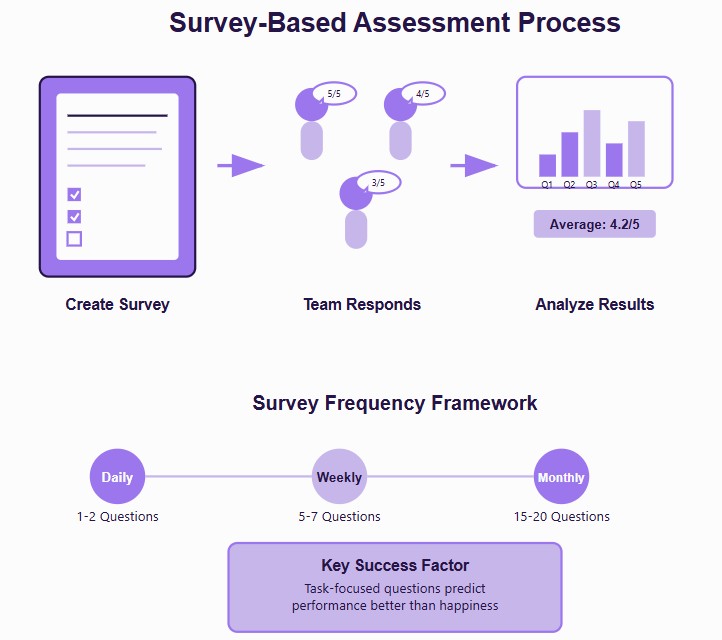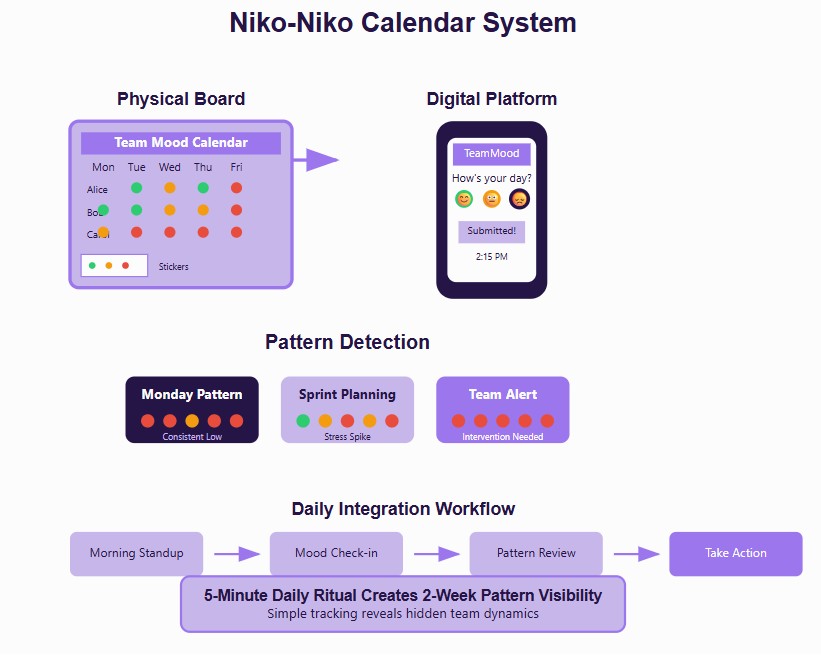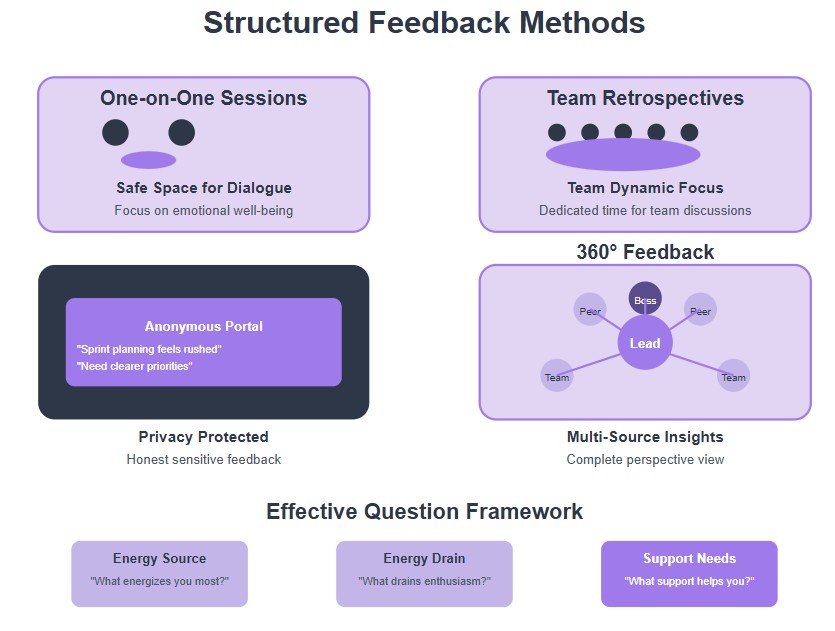Ever walked into a meeting and felt the tension before a single word was spoken? That’s morale talking.
But how can you measure a project team’s morale before it silently tanks productivity? From subtle signals to hidden dips, the real challenge isn’t spotting smiles, it’s decoding what’s underneath them. Let’s break down what most managers miss (and how you won’t).
In this article, we will explore:
- Measure team morale using methods that reveal the truth
- Benchmark morale the smart way across teams and timeframes
- Respond to low morale with actions that rebuild trust fast
6 proven methods to measure your project team's morale effectively
Measuring your project team's morale isn't just about knowing if people are happy; it's about understanding the driving force behind your team's productivity and success. Research shows that teams with high morale are 12% more productive than their counterparts, making measurement a critical component of project management success.
A. Quantitative measurement methods
Quantitative methods provide concrete, measurable data that can be tracked over time and compared across different teams. These numerical insights give you objective evidence to support your morale improvement strategies.
1. Team morale surveys and assessments
The foundation of any morale measurement program starts with scientifically validated surveys that go beyond simple happiness metrics. Unlike basic satisfaction surveys, true morale assessments focus on task orientation and team capability.
- Scientifically validated questionnaires that measure enthusiasm, meaning, and team confidence
- Key survey questions focusing on work purpose, team capability, and individual contribution value
- Frequency recommendations: Daily pulse checks (1-2 questions), weekly team surveys (5-7 questions), monthly comprehensive assessments (15-20 questions)
- Anonymous responses for honest feedback vs. identified responses for targeted coaching
- Sample size considerations: Minimum 5 team members for meaningful data, 80% response rate target

Pro Tip: Use questions like "I am enthusiastic about the work I do for my team" and "I believe my team has the capability to handle our current challenges" rather than generic happiness questions. These task-focused questions predict performance better than general satisfaction metrics.
2. Performance-based metrics
Your team's output quality and efficiency serve as indirect but powerful morale indicators. When morale drops, performance metrics typically follow suit, making these leading indicators of team health.
- Task completion rates and deadline adherence percentages
- Quality metrics, including defect rates and rework frequency
- Velocity tracking in agile environments (story points completed per sprint)
- Individual goal achievement rates are measured against set targets
- Employee utilization rates showing productive time vs. total work time

Example: A development team that typically completes 85% of sprint commitments suddenly drops to a 60% completion rate. This performance decline often signals underlying morale issues before team members explicitly express dissatisfaction.
3. Behavioral indicators
People's actions speak louder than their words, especially when it comes to morale. These observable behaviors provide real-time insights into team sentiment without requiring surveys or formal assessments.
- Attendance patterns, including tardiness frequency and early departures
- Voluntary participation in team-building activities and optional meetings
- Conflict resolution metrics: Number of conflicts and average resolution time
- Communication frequency in team channels and meetings
- Peer collaboration is measured through cross-functional project involvement
Key Insight: Teams with high morale typically show increased voluntary collaboration and faster conflict resolution. Monitor these patterns weekly to catch morale shifts early.
B. Qualitative measurement tools
Qualitative tools capture the human element that numbers alone cannot reveal. These methods provide rich context and emotional intelligence about your team's true state of mind.
4. Daily mood tracking systems
Simple, consistent mood tracking creates a visual timeline of team emotional health. The Niko-Niko Calendar approach transforms abstract feelings into trackable data points.
- Niko-Niko Calendar implementation with color-coded daily mood indicators
- Digital alternatives like TeamMood, MercuryApp for remote teams
- Color-coding systems: Green (positive), Yellow (neutral), Red (concerning)
- Integration opportunities with daily standups and sprint retrospectives

Implementation Example: Set up a 5-minute daily ritual where team members place colored stickers on a calendar or click their mood in a digital tool. After two weeks, you'll see patterns emerge, like "every Monday is red" or "sprint planning days show increased stress."
5. Regular check-ins and feedback sessions
Structured conversations provide deeper insights than any survey can capture. These sessions create safe spaces for authentic dialogue about team dynamics and individual concerns.
- One-on-one morale conversations focused on emotional well-being rather than task performance
- Team retrospectives with dedicated time for discussing team emotional health
- Anonymous suggestion systems for sensitive feedback
- 360-degree feedback incorporating morale and team dynamic elements

Best Practice: During one-on-ones, ask "What's energizing you most about our project right now?" and "What's draining your enthusiasm?" These questions reveal morale drivers more effectively than direct satisfaction queries.
6. Observational assessment techniques
Trained observation reveals unspoken team dynamics that formal assessments might miss. Body language, energy levels, and interaction patterns tell powerful stories about team morale.
- Energy level indicators during meetings and collaborative sessions
- Team interaction dynamics, including who speaks up and who remains silent
- Response patterns to challenges, setbacks, and new requirements
- Innovation indicators like creative suggestions and proactive problem-solving
Observation Framework: Spend 10 minutes each week observing team interactions during natural moments - coffee breaks, informal discussions, problem-solving sessions. High-morale teams show more spontaneous laughter, collaborative body language, and proactive communication.
Start with one quantitative method (weekly pulse surveys) and one qualitative approach (daily mood tracking) this week. Consistent measurement beats perfect measurement every time. Your team's morale and project success depend on understanding what drives your people forward.
Set the bar right: How to benchmark morale scores across teams and projects like a pro
Measuring morale is only half the equation. Without a benchmark, you don’t know whether your team is thriving, surviving, or quietly burning out. Benchmarking provides context, the “compared to what” - that transforms raw morale data into strategic insight.
Below are three essential ways to benchmark morale accurately and meaningfully.
Compare against industry morale norms
Start by understanding where your team stands compared to others in your field. Many sectors have published engagement or satisfaction benchmarks you can reference.
Typical morale engagement scores (out of 100):
- Tech/Software Development: 65–75 (often lower during crunch periods)
- Marketing & Agencies: 60–70 (morale fluctuates with client load)
- Healthcare: 55–65 (often strained by systemic pressures)
- Startups: 70–80 (early teams are usually highly driven but at burnout risk), which is why many founders turn to project management software for startups to track morale and velocity early.
Use tools like Gallup, CultureAmp, or Officevibe to find industry-specific morale averages or sentiment indices.
Why it matters: If your team’s morale is at 67 and the industry norm is 72, you know there’s a gap to explore and improve.
Use sample score benchmarks by tool or method
Most morale and engagement tools offer built-in scoring ranges. Use these to evaluate where your team falls.
Examples by method:
- Pulse Surveys (1–10 scale):
- 8–10 = Excellent
- 6–7 = Needs monitoring
- <6 = Warning sign
- Weekly Mood Trackers (Emoji or Color Scale):
- 70%+ “Green” = High morale
- 50–69% = Mixed signals
- <50% = Likely low morale
- Engagement Platforms (e.g., Officevibe, TINYpulse):
- Score of 75–85% is average
- Above 85% is considered thriving
- Below 65% often suggests morale problems
Pro Tip: Benchmark against both external averages and your historical trends; this gives you a clearer picture of progress.
Create an internal morale benchmarking framework
Sometimes, the best benchmarks are within your own walls. Comparing morale scores across teams, departments, or time periods reveals internal best practices and hidden trouble spots.
Ways to structure your internal benchmarks:
- Team vs. Department: Is the QA team’s morale lagging behind DevOps?
- Quarter-over-Quarter Trends: Did morale dip after a leadership change or sprint deadline?
- Project Type: Are certain types of projects (client-facing vs. internal) more stressful?
Why it matters: Without internal benchmarks, you’ll miss micro-trends, like one team quietly losing motivation while the org average looks fine.
Best Practice: Visualize internal morale trends using dashboards. Plot survey scores, sentiment emojis, or team check-in notes side by side.
A morale score means nothing in isolation. What’s “good” for one team might be average or alarming for another. Benchmarking unlocks insight, context, and direction. It allows you to ask better questions, spot patterns early, and take action where it counts.
Morale dip detected? Here’s exactly how to respond without making it worse
So you’ve measured morale and the results aren’t pretty. But here’s the truth: a morale dip isn’t a failure. It’s an opportunity. What matters most is how you respond. Done right, your team will feel supported and re-energized. Done wrong, you risk deepening disengagement or even losing key talent.
Let’s walk through the right way to turn insight into action without overwhelming, overpromising, or overlooking your team’s voice.

Address feedback openly - but don’t overpromise
When morale is low, teams are hyper-aware of how leadership responds. Rushing in with vague promises or overly ambitious fixes can feel performative — and create even more distrust.
Best practices to follow:
- Acknowledge the feedback respectfully: “We heard that some team members feel overwhelmed during sprint planning.”
- Be specific about what’s being reviewed or changed — no generic “we’ll look into it” replies.
- Avoid making commitments before you've validated feasibility.
Why it matters: Overpromising and underdelivering worsen morale faster than silence. Trust takes time and consistency.
Communicate transparently after every survey
The feedback loop must be closed, even if you don’t have all the answers yet. Teams want to know that their voices were heard and taken seriously.
Key actions to take:
- Share the summary of results (no names, just themes) with your team
- Be honest about what surprised or concerned you
- Outline next steps and when they’ll happen — even if the first step is “further discovery”
Example Message:
“We saw from last week’s survey that many of you feel unclear on your growth path. Over the next two weeks, we’ll run follow-up conversations to better understand where the gaps are - and what support looks like to you.”
Tip: A simple update within 5–7 days of the survey keeps morale signals from going stale or being ignored.
Co-create morale recovery plans with your team
Invite your team to become part of the morale-rebuilding process. This builds ownership, trust, and tailored solutions that work.
Ways to co-own recovery:
- Run a retrospective or workshop focused on morale drivers (e.g., workload, recognition, clarity)
- Use dot voting or mood boards to prioritize issues to address first
- Form small “morale champions” groups to test new ideas (e.g., async weeks, daily standups, peer shoutouts)
Best Practice: Keep it iterative. Treat morale recovery like an agile sprint - test, learn, improve.
Tie morale improvement to continuous feedback loops
Incorporate morale into your existing improvement frameworks like OKRs, team charters, or feedback rituals. That way, it doesn’t fade into the background after one crisis.
How to make it part of your culture:
- Add “team well-being” as a quarterly OKR key result
- Include morale reflections in sprint retrospectives
- Refresh your team charter with well-being expectations (e.g., “We speak up early if we feel overwhelmed”)
- Make morale metrics a standing dashboard item, not just a side note
Pro Tip: Visibility = Accountability. When morale health is on the wall, it stays top of mind.
Don’t just measure morale - manage it. Responding well after a dip is your leadership moment. Stay transparent, stay humble, and involve your team in building something better.
Turn morale awareness into project-winning action
Measuring your team’s morale isn’t just a feel-good exercise; it’s a strategic move that directly impacts delivery, collaboration, and retention.
From pulse surveys to behavioral cues and internal benchmarks, you now have the tools to spot issues before they become roadblocks. Don’t wait for burnout to show up in your KPIs. Make morale tracking a routine part of your leadership rhythm and watch your team’s performance follow.



_light%201.png)





